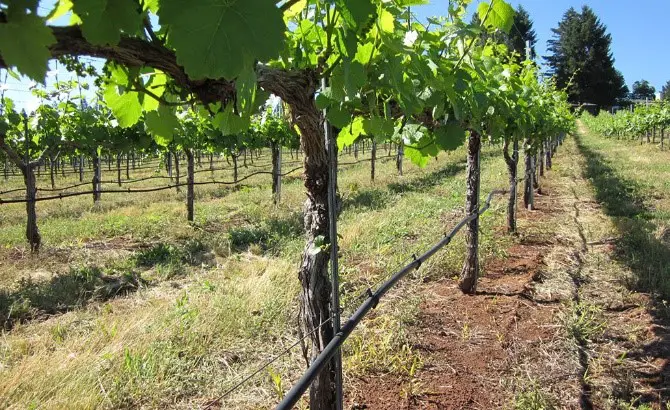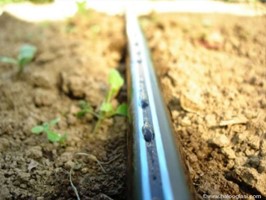Irrigation is chosen depending on the type of terrain you have and what type of climate you have. You can choose between a few different types of irrigation systems but it is better to choose after you learn the difference between them.
Our recommendation is a dripping irrigation system because it is universal for all types of terrain and climate.
Factors of irrigation
There are 2 main factors for irrigation:
- Climate
- Terrain
Climate
Climatic factors affect irrigation, in such a way that due to the climatic factors of an environment or vineyard, we have to adjust the method of irrigation.
Depending on the amount of rainfall and the temperature changes throughout the seasons the irrigation needs to be increased or decreased.
Terrain
Some of the most important soil characteristics are water retention as well as drainage.
Water retention is important because it indicates how much water the soil can absorb and thus we know how much water the vine can use before re-irrigation.
Drainage means the permeability of the soil, ie the possibility of water passing through the soil.
In viticulture, it would be desirable for the soil to have an optimal ratio of water retention and drainage.
Excessive water retention in the soil leads to excessive soil moisture and the vine consumes more water and food, the plants are more abundant at the expense of grapes, and also due to too much water retention can develop grapevine disease, especially in soils with a higher percentage of clay.
In rocky and gravelly soils, due to increased drainage of such types of soil, not enough water will be retained in the root space and therefore we have more problems with drought, which reduces the condition of the plant and thus we have poorer crop quality.
Irrigation systems
Nowadays, due to unpredictable climatic conditions, irrigation is inevitable.
Depending on the location of the vineyard, climatic conditions, and soil, it is necessary to choose an irrigation system to ensure stable growth conditions for the vine so that weather does not deceive u.
Types of irrigation
- Drip irrigation
- Sub-surface drip irrigation
- Micro-sprinklers irrigation
- Rain irrigation
- Flooding irrigation
Drip irrigation
This type of irrigation is mainly used because of water consumption because it has a low water pressure/flow it uses less water than other types of irrigation.
Because of its low water flow, it is easy to keep up with the water consumption and humidity of the soil.
The drippers dim the pressure of water flow through pipes with small exit holes which lower the volume of water flow.
This system is also used because liquid fertilizers can be applied with this irrigation method.
Some problem that may occur whit this kind of irrigation system is the occlusion of holes in the irrigation system.
This problem happens when the water is dirty, or it has a lot of limescale in it, also frequent use of fertilizers may occlude the irrigation holes.
The drip system should be placed so it can water each vine root zone.
There are 2 ways to place your drip system:
- Separate wire
- On top of the soil


Sub-surface irrigation
This method is similar to drip irrigation but for this method, you need to place the pipes underground in the root zone.
This method is good because you can’t damage the pipes when using mechanization, it can be used at any time, reduces the growth of weeds, and reduces evapotranspiration from the soil.
But there are some downsides:
the roots can damage the pipes,
the damage can’t be seen because it is underground
regular maintenance cant be done
the irrigation is localized
if you use herbicides then the pipes need to be resistant to the herbicides and that means more expensive.

Micro-sprinklers irrigation
This type of irrigation is an alternative to drip irrigation it is mainly used in plantations that use bigger spaces between plants.
The system is the same as drip irrigation but instead of drippers, it uses micro-sprinklers.
The difference is that micro-sprinklers are working on a pressure of 3,5 bar so, in that way, they can water in a radius of 5 m which means that they cover a wider range than drip irrigation systems
This type of irrigation system has some advantages over the drip system because it works on a higher water pressure there are no occlusions so it is not important to use water filters.
Some of the disadvantages of this type of irrigation are Drift problems when there is wind also it its sensitivity to areas with high evapotranspiration and the water consumption is high.
Rain Irrigation
It is the most natural way of watering vineyards because it simulates rain but because it works that way the water consumption is way higher than other irrigation systems.
The advantages of this type of irrigation system are that simulates rainfall, in warmer periods of the year it can be used to refresh vineyards, and in winter in low temperatures, it can be used as protection from freezing.
Flooding irrigation
The Flooding method is used in such a way that in the area of the vineyard, perpendicular to the direction of the rows, channels are dug through which water flows, which can be redirected to the rows of vineyards for irrigation using water pumps.
The disadvantages of this type of irrigation system are that a lot of water is lost by evaporation, and it is not compatible with all areas of grape growing.